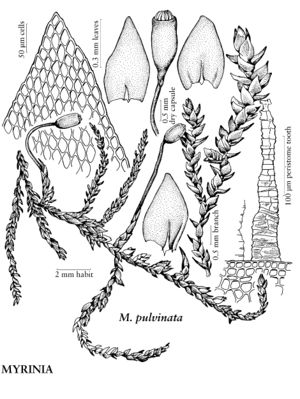familyMyriniaceae
genusMyrinia
Show Lower Taxa
Myrinia
Syn. Musc. Eur., 482. 1860.
Etymology: For Claes Gustav Myrin, 1803 – 1835, Swedish bryologist
| Taxon | Illustrator ⠉ | |
|---|---|---|
 | Myrinia pulvinata | Patricia M. Eckel |
Plants small. Stems often and irregularly branched. Stem and branch leaves with shape and size similar; margins entire; costa single; medial and distal laminal cells short-rhomboidal. Sexual condition autoicous. Seta pale-yellow. Capsule with operculum convex-conic.
Distribution
n North America, South America (Brazil), Europe, Asia
Discussion
Species 2 (1 in the flora).
The second species in the genus, Myrinia brasiliensis (Hampe) Schimper, is known from Brazil.
Selected References
None.
Lower Taxa
... more about "Myrinia"
absent +
terete-foliate +
appressed +
spreading +
concave;ovate;ovatelanceolate +
differentiated +
spreading +
naked +
cucullate +
light;dark-brown +
erect;suberect +
oblong;oblong-cylindric +
absent +
rudimentary +
2-fid +
single +
projecting +
papillose +
yellow +
cross-striolate +
papillose +
equaling +
oblong-lanceolate +
faint +
dense +
convex-conic +
ovate +
absent +
sheathing +
Syn. Musc. Eur., +
1860 +
twisted +
pale-yellow +
elongate +
yellow +
spheric +
branched +
appressed +
creeping +
spreading +
concave;ovate;ovatelanceolate +
differentiated +
Myrinia +
Myriniaceae +
genus +
firm +
small +